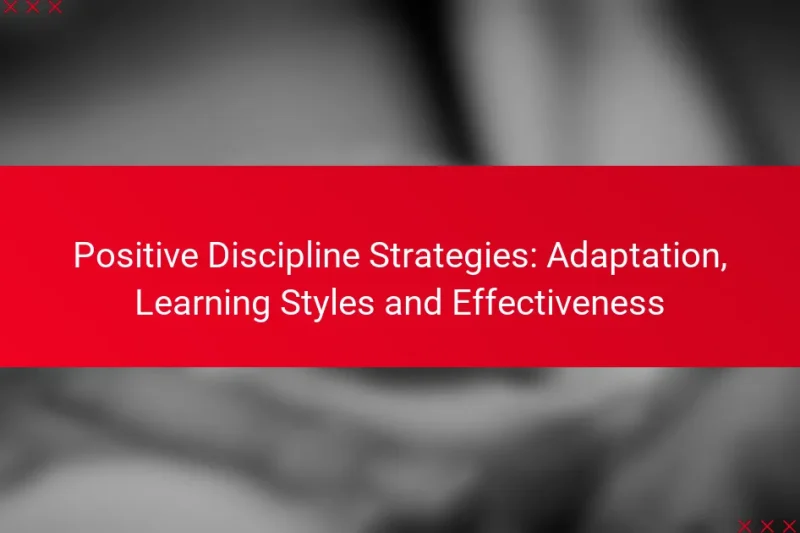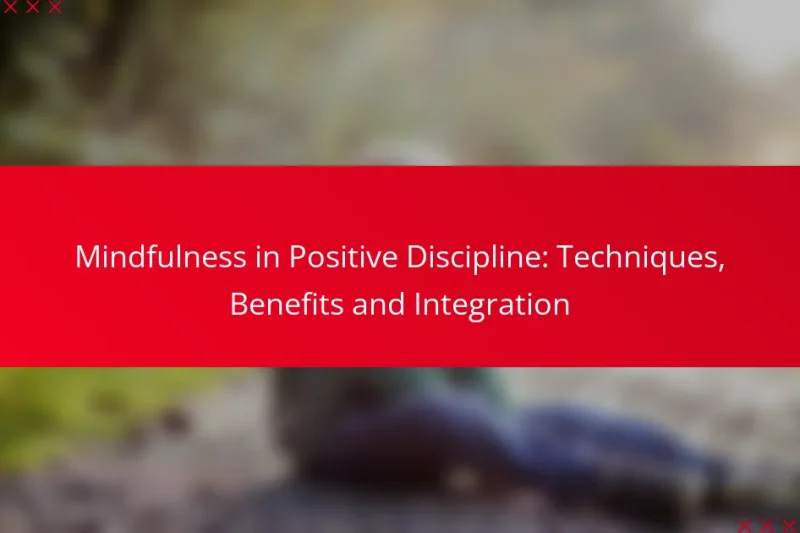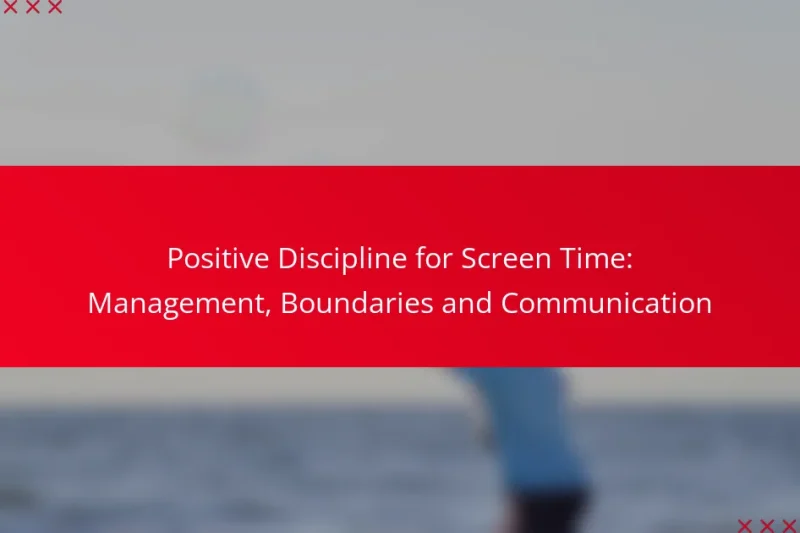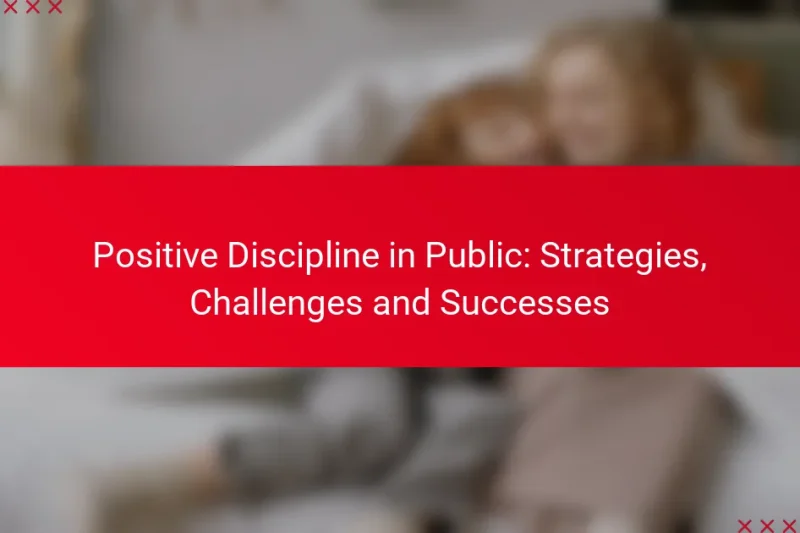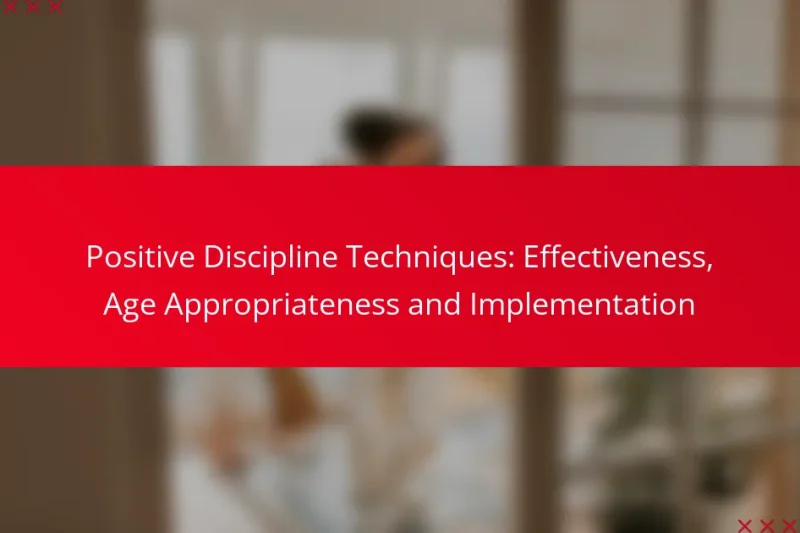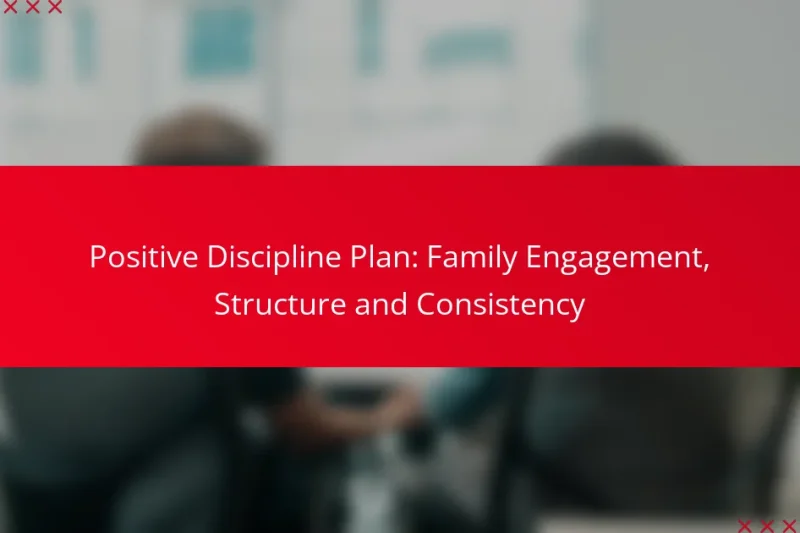Positive reinforcement is a powerful tool that fosters improved behavior, motivation, and learning outcomes by rewarding … Positive Reinforcement: Benefits, Methods and ApplicationsRead more
Positive Discipline Techniques for Effective Implementation
Positive discipline techniques are essential strategies that encourage respectful behavior and create a nurturing environment for both learning and personal growth. By focusing on teaching rather than punishment, these methods help children understand the consequences of their actions and cultivate self-discipline, ultimately leading to a more harmonious and productive classroom atmosphere.
Positive Discipline Strategies: Adaptation, Learning Styles and Effectiveness
Positive discipline strategies prioritize teaching over punishment, fostering emotional growth and responsible behavior in children. By … Positive Discipline Strategies: Adaptation, Learning Styles and EffectivenessRead more
Mindfulness in Positive Discipline: Techniques, Benefits and Integration
Mindfulness in positive discipline equips parents and educators with techniques to manage their responses to children’s … Mindfulness in Positive Discipline: Techniques, Benefits and IntegrationRead more
Positive Discipline for Screen Time: Management, Boundaries and Communication
Managing screen time for children requires the establishment of clear boundaries and effective communication to promote … Positive Discipline for Screen Time: Management, Boundaries and CommunicationRead more
Positive Discipline in Public: Strategies, Challenges and Successes
Positive discipline in public settings is a proactive approach that emphasizes communication, reinforcement, and community involvement … Positive Discipline in Public: Strategies, Challenges and SuccessesRead more
Positive Discipline Techniques: Effectiveness, Age Appropriateness and Implementation
Positive discipline techniques emphasize guiding children’s behavior through supportive and constructive methods rather than punishment, fostering … Positive Discipline Techniques: Effectiveness, Age Appropriateness and ImplementationRead more
Positive Discipline Plan: Family Engagement, Structure and Consistency
A positive discipline plan emphasizes the importance of family engagement, structure, and consistency in fostering a … Positive Discipline Plan: Family Engagement, Structure and ConsistencyRead more
What are effective positive discipline techniques?
Effective positive discipline techniques are strategies that promote respectful behavior and foster a supportive environment for learning and growth. These methods focus on teaching rather than punishing, encouraging children to understand the impact of their actions and develop self-discipline.
Restorative practices
Restorative practices involve repairing harm and restoring relationships after conflicts. This technique encourages open dialogue between those affected, allowing individuals to express feelings and take responsibility for their actions. For example, a student who disrupts class might meet with the teacher and affected classmates to discuss the incident and agree on steps to make amends.
Implementing restorative practices requires a safe environment where all participants feel comfortable sharing their perspectives. Training staff in these techniques can enhance their effectiveness and promote a culture of empathy and accountability within the classroom.
Positive reinforcement
Positive reinforcement is the practice of rewarding desirable behaviors to encourage their recurrence. This can include verbal praise, tangible rewards, or privileges that reinforce good behavior. For instance, a teacher might give extra recess time to students who consistently follow classroom rules.
To maximize the impact of positive reinforcement, it’s essential to be specific about what behavior is being rewarded. This clarity helps children understand what actions are valued and encourages them to repeat those behaviors in the future.
Clear expectations
Establishing clear expectations involves communicating specific rules and guidelines to children. This clarity helps them understand what is expected and reduces confusion. For example, outlining classroom rules at the beginning of the school year and revisiting them regularly can set a strong foundation for behavior.
When expectations are clear, it becomes easier to address misbehavior. Children are more likely to follow rules when they know the consequences of their actions and the behaviors that are encouraged.
Consistent consequences
Consistent consequences are essential for maintaining order and fairness in any discipline strategy. When children understand that certain behaviors will always result in specific outcomes, they are more likely to think twice before acting out. For instance, if a student disrupts class, a predetermined consequence, such as a time-out or loss of privileges, should be applied consistently.
It’s important to ensure that consequences are proportional to the behavior and are applied fairly across all students. This consistency builds trust and reinforces the idea that rules apply equally to everyone.
Collaborative problem-solving
Collaborative problem-solving involves working together with children to find solutions to behavioral issues. This technique empowers students to take part in the decision-making process, fostering a sense of ownership over their actions. For example, if a student is struggling with peer interactions, the teacher can facilitate a discussion to identify the problem and brainstorm potential solutions together.
Encouraging collaboration not only helps resolve conflicts but also teaches valuable skills such as negotiation and empathy. This approach can lead to more effective and lasting behavioral changes, as students feel heard and involved in the process.
How can positive discipline be implemented in schools?
Positive discipline can be effectively implemented in schools by fostering a culture of respect and understanding among students and staff. This approach emphasizes teaching students about appropriate behavior rather than merely punishing misbehavior.
Training for educators
Training for educators is essential in implementing positive discipline techniques. Professional development programs should focus on strategies that promote empathy, conflict resolution, and effective communication. Workshops can provide educators with practical tools and role-playing scenarios to practice these techniques.
Regular training sessions can help reinforce these skills, ensuring that all staff members are aligned in their approach. Schools might consider peer mentoring or coaching to support ongoing learning and application of positive discipline strategies.
Creating a supportive environment
Creating a supportive environment involves establishing clear expectations and consistent routines that foster a sense of safety and belonging. Schools should encourage positive relationships among students and staff, which can be achieved through team-building activities and collaborative projects.
Visual reminders of behavioral expectations, such as posters or classroom agreements, can help reinforce a positive atmosphere. Additionally, recognizing and celebrating positive behavior can motivate students to engage in constructive actions.
Engaging parents in the process
Engaging parents in the positive discipline process is crucial for consistency between home and school. Schools can organize workshops or informational sessions to educate parents about positive discipline techniques and the benefits of collaboration.
Regular communication, such as newsletters or parent-teacher conferences, can keep parents informed and involved. Schools should encourage feedback from parents to create a partnership that supports students’ behavioral development and reinforces positive discipline at home.
What are the benefits of positive discipline?
Positive discipline offers numerous advantages that contribute to a healthier learning environment. It fosters respect, responsibility, and problem-solving skills among students, leading to a more productive classroom atmosphere.
Improved student behavior
Implementing positive discipline techniques can significantly enhance student behavior. By focusing on constructive feedback and encouragement rather than punishment, students learn to make better choices. Techniques such as setting clear expectations and providing consistent consequences can lead to a noticeable reduction in disruptive actions.
For example, using a reward system for positive behaviors can motivate students to engage more positively in their learning. This approach not only curbs negative behavior but also reinforces desirable actions, creating a more harmonious classroom dynamic.
Enhanced teacher-student relationships
Positive discipline strengthens the bond between teachers and students. When educators employ supportive strategies, students feel valued and understood, which fosters trust. This trust encourages open communication, making it easier for students to express their concerns and seek help when needed.
Building these relationships can involve regular check-ins or collaborative problem-solving sessions, allowing students to feel more connected to their teachers. This connection can lead to a more engaged classroom where students are willing to participate and share their thoughts.
Increased academic performance
Students who experience positive discipline often show improvements in academic performance. A supportive environment reduces anxiety and distractions, allowing students to focus better on their studies. When students feel safe and respected, they are more likely to take academic risks and strive for excellence.
Research indicates that classrooms with positive discipline practices can see performance gains, with students achieving higher grades and demonstrating improved understanding of the material. Encouraging a growth mindset through positive reinforcement can further enhance these academic outcomes.
What challenges might arise with positive discipline?
Implementing positive discipline can present several challenges, including resistance from staff, lack of resources, and inconsistent application. Addressing these issues is crucial for the successful adoption of positive discipline techniques in any organization.
Resistance from staff
Resistance from staff is a common challenge when introducing positive discipline. Some educators may be accustomed to traditional disciplinary methods and may feel uncomfortable with new approaches. To mitigate this, provide training sessions that clearly outline the benefits of positive discipline and involve staff in the decision-making process.
Encouraging open dialogue can help address concerns and foster a supportive environment. Consider forming a committee that includes staff members to discuss their experiences and suggestions regarding discipline practices.
Lack of resources
A lack of resources can hinder the effective implementation of positive discipline strategies. This may include insufficient training materials, limited access to professional development, or inadequate support staff. Organizations should assess their current resources and identify gaps that need to be filled.
To overcome this challenge, seek partnerships with local educational institutions or community organizations that can provide training and support. Additionally, consider utilizing online resources and free workshops to enhance staff knowledge without significant financial investment.
Inconsistent application
Inconsistent application of positive discipline techniques can undermine their effectiveness. When different staff members apply varying approaches, it can lead to confusion among students and diminish the overall impact of discipline strategies. Establishing clear guidelines and expectations is essential for consistency.
Regular training and follow-up sessions can help ensure that all staff members are on the same page. Implementing a system for monitoring and providing feedback on discipline practices can also promote uniformity and accountability across the organization.
How does positive discipline differ from traditional discipline?
Positive discipline focuses on teaching children appropriate behaviors rather than simply punishing them for misbehavior. While traditional discipline often relies on consequences to deter unwanted actions, positive discipline encourages understanding and skill development to foster long-term behavioral change.
Focus on teaching rather than punishment
Positive discipline emphasizes the importance of teaching children the reasons behind rules and the skills needed to make better choices. Instead of imposing penalties, caregivers guide children through discussions and problem-solving exercises that help them understand the impact of their actions.
For example, if a child interrupts during a conversation, a positive discipline approach would involve explaining why listening is important and practicing taking turns in communication. This method not only addresses the behavior but also equips the child with valuable social skills.
To implement this effectively, caregivers should ask open-ended questions that encourage reflection, such as “How do you think that made your friend feel?” This promotes empathy and critical thinking, which are essential for personal growth.

